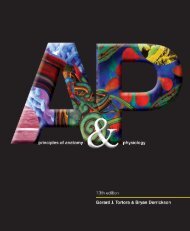urinalysis and body fluids
Create successful ePaper yourself
Turn your PDF publications into a flip-book with our unique Google optimized e-Paper software.
©2008 F. A. Davis<br />
CHAPTER 3 • Introduction to Urinalysis 31<br />
Should it be necessary to determine whether a particular<br />
fluid is urine, the specimen can be tested for its urea <strong>and</strong><br />
creatinine content. Because both these substances are present<br />
in much higher concentrations in urine than in other <strong>body</strong><br />
<strong>fluids</strong>, a high urea <strong>and</strong> creatinine content can identify a fluid<br />
as urine.<br />
Figure 3–3 A chart used for urine analysis. (Courtesy of<br />
National Library of Medicine)<br />
■ ■ ●<br />
Urine Formation<br />
As detailed in Chapter 2, the kidneys continuously form urine<br />
as an ultrafiltrate of plasma. Reabsorption of water <strong>and</strong> filtered<br />
substances essential to <strong>body</strong> function converts approximately<br />
170,000 mL of filtered plasma to the average daily<br />
urine output of 1200 mL.<br />
■ ■ ●<br />
Urine Composition<br />
In general, urine consists of urea <strong>and</strong> other organic <strong>and</strong> inorganic<br />
chemicals dissolved in water. Urine is normally 95%<br />
water <strong>and</strong> 5% solutes, although considerable variations in the<br />
concentrations of these solutes can occur owing to the influence<br />
of factors such as dietary intake, physical activity, <strong>body</strong><br />
metabolism, endocrine functions, <strong>and</strong> even <strong>body</strong> position.<br />
Urea, a metabolic waste product produced in the liver from<br />
the breakdown of protein <strong>and</strong> amino acids, accounts for<br />
nearly half of the total dissolved solids in urine. Other organic<br />
substances include primarily creatinine <strong>and</strong> uric acid. The<br />
major inorganic solid dissolved in urine is chloride, followed<br />
by sodium <strong>and</strong> potassium. Small or trace amounts of many<br />
additional inorganic chemicals are also present in urine (Table<br />
3–1). Dietary intake greatly influences the concentrations of<br />
these inorganic compounds, making it difficult to establish<br />
normal levels. Other substances found in urine include<br />
hormones, vitamins, <strong>and</strong> medications. Although not a part of<br />
the original plasma filtrate, the urine also may contain formed<br />
elements, such as cells, casts, crystals, mucus, <strong>and</strong> bacteria.<br />
Increased amounts of these formed elements are often indicative<br />
of disease.<br />
Urine Volume<br />
■ ■ ●<br />
Urine volume depends on the amount of water that the kidneys<br />
excrete. Water is a major <strong>body</strong> constituent; therefore, the<br />
amount excreted is usually determined by the <strong>body</strong>’s state<br />
of hydration. Factors that influence urine volume include<br />
fluid intake, fluid loss from nonrenal sources, variations in<br />
the secretion of antidiuretic hormone, <strong>and</strong> need to excrete<br />
increased amounts of dissolved solids, such as glucose or<br />
salts. Taking these factors into consideration, although the<br />
normal daily urine output is usually 1200 to 1500 mL, a<br />
range of 600 to 2000 mL is considered normal.<br />
Oliguria, a decrease in urine output, which is less<br />
than 1 mL/kg/hr in infants, less than 0.5 mL/kg/hr in children,<br />
<strong>and</strong> less than 400 mL/day in adults, is commonly seen<br />
when the <strong>body</strong> enters a state of dehydration as a result<br />
of excessive water loss from vomiting, diarrhea, perspiration,<br />
or severe burns. Oliguria leading to anuria, cessation of<br />
urine flow, may result from any serious damage to the kidneys<br />
or from a decrease in the flow of blood to the kidneys.<br />
The kidneys excrete two to three times more urine<br />
during the day than during the night. An increase in the<br />
nocturnal excretion of urine is termed nocturia. Polyuria,<br />
an increase in daily urine volume (greater than 2.5 L/day<br />
in adults <strong>and</strong> 2.5–3 mL/kg/day in children), is often associated<br />
with diabetes mellitus <strong>and</strong> diabetes insipidus; however,<br />
it may be artificially induced by diuretics, caffeine, or<br />
alcohol, all of which suppress the secretion of antidiuretic<br />
hormone.<br />
Diabetes mellitus <strong>and</strong> diabetes insipidus produce<br />
polyuria for different reasons, <strong>and</strong> analysis of the urine is<br />
an important step in the differential diagnosis (Fig. 3-4).<br />
Diabetes mellitus is caused by a defect either in the pancreatic<br />
production of insulin or in the function of insulin, which<br />
results in an increased <strong>body</strong> glucose concentration. The<br />
kidneys do not reabsorb excess glucose, necessitating excretion<br />
of increased amounts of water to remove the dissolved<br />
glucose from the <strong>body</strong>. Although appearing to be dilute,<br />
a urine specimen from a patient with diabetes mellitus has<br />
a high specific gravity because of the increased glucose<br />
content.<br />
Diabetes insipidus results from a decrease in the production<br />
or function of antidiuretic hormone; thus, the water<br />
necessary for adequate <strong>body</strong> hydration is not reabsorbed from<br />
the plasma filtrate. In this condition, the urine is truly dilute<br />
<strong>and</strong> has a low specific gravity. Fluid loss in both diseases is<br />
compensated by increased ingestion of water (polydipsia),<br />
producing an even greater urine volume. Polyuria accompanied<br />
by increased fluid intake is often the first symptom of<br />
either disease.

















